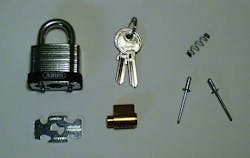The laminated padlock has always been a security product that actually looks secure. The gray metal, rough finished laminate body is built from a number of individually stacked, thick and solid looking hardened steel plates. The laminated body is held together with rivets. As a final security statement, the oversized rivet heads stand out from the top and bottom plates. What makes the laminated padlock even more impressive is that the larger they are, the greater the level of security they offer.
The laminated body padlock has been around for many years, visually unchanged for these years. And probably since its introduction, there has been a need to manufacture a re-keyable version of the laminated padlock.
To that end, ABUS has introduced the 41UK Series Re-Keyable Laminated Padlock, a double bolt locking padlock design that secures both the heel and the tool of the shackle. The 40 mm (1-½") wide laminated body padlock has four countersunk rivets that secure the 19 laminates in place. A 20th hardened steel laminate, the cover plate is riveted into position securing the lock cylinder once it has been combinated and installed. The keyway opening in the cover plate is minimal, forming a guard to resist drill attacks.
ABUS 41UK Series Padlocks are designed to be keyed to any bitting of the two available lock cylinders’ keyways. The 41UK padlocks are available with the ABUS RH5 keyway, a five-pin tumbler lock cylinder or an ABUS M1 keyway, a four-pin tumbler lock cylinder. The M1 keyway lock cylinders use pin tumblers, and spaces and depths compatible with existing padlocks.
To make re-keying practical, these 1-½" wide bodied laminated padlocks come without the cover plate secured by the four rivets. The lock cylinder and shackle spring are also not installed. In this condition, the shackle can be removed and a different length shackle can be installed. To increase the versatility of the 41UK Series padlocks, three available lengths of shackles have openings of 1", 1-½" or 2". ABUS shackles are white zinc plated hardened metal alloy.
Each 41UK complete padlock will contain:
• Padlock Body with shackle
(shackle not secured, it can be removed)
• 2 Hardened Steel Rivets
• Hardened Steel Bottom Plate
• Shackle Spring
• Lock Cylinder (first depth bitted)
For this article, I will assemble a 41UK/40 RH5 - OB padlock having the ABUS keyway five- pin tumbler lock cylinder. These padlock lock cylinders are bottom loaded. Each lock cylinder comes from the factory “0” bitted. To re-key, determine the new bitting. The 41UK Series use the smaller padlock style pin tumblers.
Spacing: Shoulder stop Cut-to-cut .122"
1- .157" 2- .280" 3- .402" 4- .524" 5- .646"
Depths Drop .0255"
1- .254" 2- .228" 3- .203" 4- .177" 5- .152"
Maximum Adjacent Cut Specification (MACS) is a three.
HPC 1200CM card is C112. Ilco Universal Code Machine card is 500.
REKEYING
To re-key the lock cylinder, the bottom pins must first be removed. Insert the operating key into the keyway and carefully rotate the plug one half revolution. In this position, the tops of the bottom pins should align with the openings in the bottom of the lock cylinder. Carefully remove the four or five bottom pins through the holes in the bottom of the lock cylinder. Once all of the bottom pins have been removed, do not rotate the plug.
Carefully remove the key. Insert the new key without moving the plug out of position. The plug pin chambers must line up with the openings in the bottom of the housing in order for the new bottom pins to load.
Insert the new bottom pins with the tips entering into the pin chambers first. This way the tips of the bottom pins will contact the key blade. The new bottom pins must align with the top of the plug, not the top of the housing. Use a suitable probe to press against each bottom pin to be certain they are at the proper depth. If any of the bottom pins are too short for the depth of cut, there will be a gap between the outer diameter of the plug and the height of the pin. If any of the bottom pins are too tall, they will extend out of the plug into the housing and will not permit the plug to be rotated.
Once the lock cylinder has been combinated, rotate the key to the locked position and remove. Always test the operation of all of the keys before the lock cylinder is installed into the padlock.
ASSEMBLY
To assemble the ABUS 41UK Series Padlock:
Without having the key in the lock cylinder, carefully insert the cylinder into the padlock body.
While holding the lock cylinder in place, insert the key and operate the lock in order to release the shackle. Pull out on the shackle just far enough to clear the leg. The shackle is not spring loaded at this time. Releasing the shackle provides additional room in order to insert the shackle spring.
If the shackle is being replaced, it should be changed out now.
Turn the padlock upside down, having the shackle hanging down.
Remove the key, leaving the lock cylinder in place.
Insert the shackle spring into the shackle slot.
Place the cover plate onto the body with the lettering visible. While holding the cover in place, insert the two provided rivets into the holes. While holding the cover plate in position, insert a key and make sure the padlock can be unlocked. Test the padlock with each key.
When you are certain the padlock operates properly, secure the two rivets using a rivet gun.
Next, secure the shackle. Because the shackle can be changed, the final step is to hammer the shackle retainer flat. The shackle retainer is located on the side of the eighth laminate. Hammering the shackle retainer flush with the other laminates obstructs the shackle slot, permanently mounting the shackle into the padlock body.
To secure, lock the shackle into the padlock body. Place the padlock body onto flat side with the protruding laminate (shackle retainer) pointing up. Use a hammer to pound this laminate flush.
The ABUS 41UK Padlocks are available as complete units with different shackle lengths and less shackle. Replacement components include steel rivets, lock cylinders, shackles and springs, and bottom plates.
The 41UK Series Padlocks equipped with the RH5 keyway lock cylinders can be rekeyed using the ABUS 24SK1 Pinning Kit. This kit can be used to combinate specific models of the ABUS Diskus®, laminated, brass and solid steel padlocks. The pin tumblers contained in the 24SK1 Pinning Kit are balanced. There are five depths of pin tumblers. Each bottom pin has a specific top pin.
Because of the similarities of this very commonly used key blade shape, it is better to use original equipment RH5 keyway key blanks. The ABUS key blank number is 24RK/26KBR.
For more information, contact your local locksmith wholesaler or ABUS Lock Company, 23910 N. 19th Ave. #56, Phoenix, AZ 85085. Telephone: 623-516-9933. Fax: 623-516-9934. Web Site: www.abuslock.com





